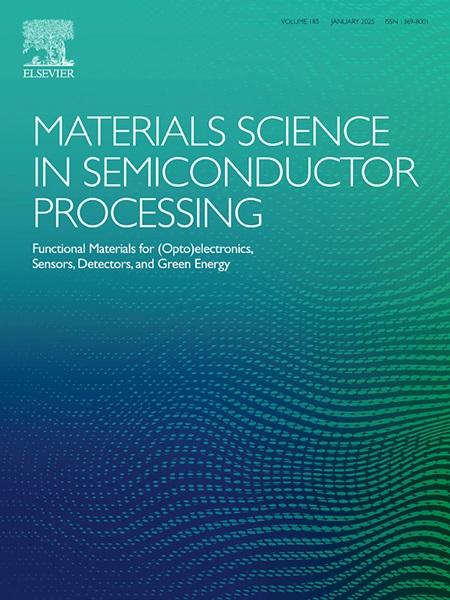Implementation of thin film metallic-glass/Cu (TFMG/Cu) Bi-layer as diffusion barrier in Cu/Sn/Cu bonding structures for IC interconnection
IF 4.2
3区 工程技术
Q2 ENGINEERING, ELECTRICAL & ELECTRONIC
引用次数: 0
Abstract
The development of three-dimensional integrated circuits and advancements in electronic packaging technology have increased the volume fraction of intermetallic compounds during the miniaturization of solder joints, thereby dominating the material properties of the solder joints. Thin film of metallic glass (TFMG) is an excellent diffusion barrier material. When maintained below its crystallization temperature, it retains its amorphous state, meaning that its barrier performance is completely independent of film thickness, and they exhibit good thermal stability. This characteristic provides significant advantages for the miniaturization of next-generation electronic devices. To ensure that a moderate amount of IMC remain in the solder joints without excessive growth, this study proposes the use of a bilayer thin film composed of metallic glass (Zr69Cu24Ti7) and Cu as a diffusion barrier to regulate the interfacial reaction at the Cu/Sn/Cu interface. We investigated the influence of thermal compression bonding temperature on the development of IMC regulated by the use of a bilayer thin film diffusion barrier and showed that thermal compression bonding had optimal results at temperatures between 250 °C and 300 °C. Within this temperature range, the bilayer thin film effectively suppressed the excessive diffusion and reaction between Cu and Sn, reducing IMC overgrowth and preventing the formation of Kirkendall voids. The rounded Cu6Sn5 were the main IMC that formed in random distribution within the solder joints. This controlled diffusion promoted uniform and predictable IMC growth, effectively managing IMC morphology during bonding. It can be observed that this enhances resistance to thermal and mechanical stresses commonly encountered in 3D interconnect applications, contributing to the advancement and application of 3D IC packaging technologies.
薄膜金属玻璃/Cu (TFMG/Cu)双层作为Cu/Sn/Cu键合结构中扩散势垒的实现
三维集成电路的发展和电子封装技术的进步,使得焊点微型化过程中金属间化合物的体积分数增加,从而主导了焊点的材料性能。金属玻璃薄膜是一种优良的扩散阻隔材料。当保持在其结晶温度以下时,它保持其无定形状态,这意味着它的阻挡性能完全独立于薄膜厚度,并且它们表现出良好的热稳定性。这一特性为下一代电子器件的小型化提供了显著的优势。为了保证适量的IMC留在焊点中而不过度生长,本研究提出使用金属玻璃(Zr69Cu24Ti7)和Cu组成的双层薄膜作为扩散屏障来调节Cu/Sn/Cu界面的界面反应。我们研究了热压键合温度对利用双层薄膜扩散屏障调节的IMC发展的影响,结果表明热压键合温度在250°C至300°C之间具有最佳效果。在此温度范围内,双层薄膜有效抑制了Cu和Sn之间的过度扩散和反应,减少了IMC的过度生长,防止了Kirkendall空洞的形成。圆形Cu6Sn5是主要的IMC,在焊点内随机分布。这种受控扩散促进了均匀和可预测的IMC生长,有效地控制了键合过程中的IMC形态。可以观察到,这增强了对3D互连应用中常见的热应力和机械应力的抵抗力,有助于3D IC封装技术的进步和应用。
本文章由计算机程序翻译,如有差异,请以英文原文为准。
求助全文
约1分钟内获得全文
求助全文
来源期刊

Materials Science in Semiconductor Processing
工程技术-材料科学:综合
CiteScore
8.00
自引率
4.90%
发文量
780
审稿时长
42 days
期刊介绍:
Materials Science in Semiconductor Processing provides a unique forum for the discussion of novel processing, applications and theoretical studies of functional materials and devices for (opto)electronics, sensors, detectors, biotechnology and green energy.
Each issue will aim to provide a snapshot of current insights, new achievements, breakthroughs and future trends in such diverse fields as microelectronics, energy conversion and storage, communications, biotechnology, (photo)catalysis, nano- and thin-film technology, hybrid and composite materials, chemical processing, vapor-phase deposition, device fabrication, and modelling, which are the backbone of advanced semiconductor processing and applications.
Coverage will include: advanced lithography for submicron devices; etching and related topics; ion implantation; damage evolution and related issues; plasma and thermal CVD; rapid thermal processing; advanced metallization and interconnect schemes; thin dielectric layers, oxidation; sol-gel processing; chemical bath and (electro)chemical deposition; compound semiconductor processing; new non-oxide materials and their applications; (macro)molecular and hybrid materials; molecular dynamics, ab-initio methods, Monte Carlo, etc.; new materials and processes for discrete and integrated circuits; magnetic materials and spintronics; heterostructures and quantum devices; engineering of the electrical and optical properties of semiconductors; crystal growth mechanisms; reliability, defect density, intrinsic impurities and defects.
 求助内容:
求助内容: 应助结果提醒方式:
应助结果提醒方式:


